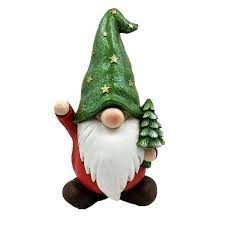

Garden gnomes (German: Gartenzwerge, lit. 'garden dwarfs') are lawn ornament figurines of small humanoid creatures based on the mythological creature and diminutive spirit which occur in Renaissance magic and alchemy, known as gnomes. They also draw on the German folklore of the dwarf.
Traditionally, the garden figurines depict male dwarfs wearing red pointy hats. Typically, gnomes stand between one and two feet (30 and 60 cm). Originating as a decoration for the wealthy in Europe, garden gnomes are now prevalent in gardens and lawns throughout the Western world, among all social classes. They are regarded by some as kitsch.
Garden gnomes are typically male, often bearded, usually wear red phrygian caps and often have pipes. They are often shown pursuing leisurely pastimes such as fishing or napping.
Gnomes may be made from terracotta clay slip (runny clay) poured into molds. This is allowed to set up and the excess emptied from the centre, leaving a clay shell. The gnome is removed from the mold when firm, allowed to dry and then fired in a kiln until hard. Once cooled, the gnome is painted. More modern gnomes are made from resins and similar materials.
Today, many different variations of garden gnomes exist, including humorous ones ranging from the lighthearted biker or barbecuing gnome, to the more dark, such as one stabbed in the back or wearing an executioner's hood.[citation needed][better source needed]

The traditional gnome is closely linked to the mythology of the classical elements (Earth, Fire, Water, and Air) and were said to be the nocturnal protectors of the Earth. Legend has it that gnomes live underground, where they guard the nearby plant life (as well as their personal stashes of buried treasure).

Why do we put gnomes in the garden? The Complete Wonderful History of Garden Gnomes – Sunnydaze Decor These were statues of the Roman gods and the most common one was Priapus, a god of fertility derived from Greek mythology. The gnome statue, and other statues like it, were used in gardens to ensure a bountiful harvest by protecting the animals and plants. They also were said to keep evil spirits away.